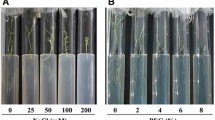Abstract
Common polypody (Polypodium vulgare L.) belongs to desiccation-tolerant ferns. The structure of storage parenchyma of their rhizome was examined by transmission electron microscopy after dehydration and subsequent rewetting. Analysis revealed that treatment with supplemental abscisic acid resulted in protection of cells against ultrastructural damage compared to untreated ones. Dehydration rate appears to modify the ability of rhizome parenchyma to stand water stress.
Similar content being viewed by others
Abbreviations
- ABA:
-
abscisic acid
- DT:
-
desiccation-tolerant
- ER:
-
endoplasmic reticulum
- TEM:
-
transmission electron microscopy
References
Bagniewska-Zadworna, A., Zenkteler, E.: In vitro storage of Polypodium vulgare L. rhizome shoot tips using ABA treatment before dehydration-encapsulation technique.-Acta biol. cracov. Ser. Bot. 44: 231–236, 2002.
Bagniewska-Zadworna, A., Zenkteler, E.: Changes in carbohydrate contents in rhizome explants of Polypodium vulgare in response to water stress.-Acta Physiol. Plant. 25: 46–47, 2003.
Brighina, L., Bennici, A., Tani, C., Tani, G.: Structural and ultrastructural characterization of Selaginella lepidophylla, a desiccation-tolerant plant, during the rehydration process.-Flora 197: 81–91, 2002.
Cooper, K., Farrant, J.M..: Recovery of the resurrection plant Craterostigma wilmsii from desiccation: protection versus repair.-J. exp. Bot. 53: 1805–1813, 2002.
Duke, J.A., Handbook of Phytochemical Constituents of Grass Herbs and Other Economic Plants.-CRC Press, Boca Raton 2001.
Farrant, J.M.: A comparison of mechanisms of desiccation tolerance among three angiosperm resurrection plant species.-Plant Ecol. 151: 29–39, 2000.
Grzybek, J.: Phytochemical and biological investigations on Polypodium vulgare L.-Acta pol. pharm. 2: 259–263, 1983.
Mills, D.: Natural rubber production in arid and semiarid zones.-In: Antzen, C.J. (ed.): Encyclopedia of Agricultural Sciences. Vol. 3. Pp. 73–86. Academic Press, San Diego 1994.
Ogura, Y.: Comparative Anatomy of Vegetative Organs of the Pteridophytes. Handbook of Plant Anatomy. Borntrager, Berlin 1972.
Reynolds, E.S.: The use of lead citrate at high pH as an electron microscopy.-J. Cell Biol. 17: 208–212, 1963.
Reynolds, T.L., Bewley, J.D.: Characterization of protein synthetic changes in a desiccation-tolerant fern, Polypodium virginianum. Comparison of the effects of drying, rehydration and abscisic acid.-J. exp. Bot. 44: 921–928, 1993.
Spurr, A.R.: A low-viscosity epoxy resin embedding medium for electron microscopy.-J. Ultrastruct. Res. 26: 31–43, 1969.
Zenkteler, E.: Micropropagation of Polypodium vulgare L by rhizome explants.-Bull. Polish Acad. Sci., biol. Sci. 43: 77–84, 1995.
Zenkteler, E., Grzybek, J.: Ecdysteroids in tissue culture of Polypodium vulgare L-In: Abstracts of International Symposium ‘Pteridology in Perspective’. P. 109. Kew Botanic Garden, London 1995.
Author information
Authors and Affiliations
Corresponding author
Rights and permissions
About this article
Cite this article
Zenkteler, E., Bagniewska-Zadworna, A. Ultrastructural changes in rhizome parenchyma of Polypodium vulgare during dehydration with or without abscisic acid pretreatment. Biol Plant 49, 209–214 (2005). https://doi.org/10.1007/s10535-005-0214-3
Received:
Accepted:
Issue Date:
DOI: https://doi.org/10.1007/s10535-005-0214-3



